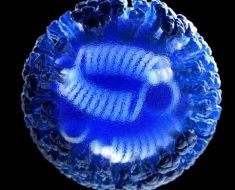Berries, red wine, and other foods rich in flavonoids are associated with a lower risk for death in patients with Parkinson’s disease (PD), new research suggests.
In a prospective analysis of more than 1200 participants with an eventual PD diagnosis, those who ate three or more servings of flavonoid-rich foods a week had a 70% lower mortality vs those consuming one or fewer servings of such foods per month.

Dr Xiang Gao
“Adopting a healthy dietary pattern that is high in colorful fruits and veggies like berries, even after a Parkinson diagnosis, could slow disease progression and improve survival rate,” study investigator Xiang Gao, MD, PhD, professor and director, Nutritional Epidemiology Lab, Department of Nutritional Sciences, the Pennsylvania State University, in University Park, told Medscape Medical News.
The findings were published online January 26 in Neurology.
First Evidence of Survival Advantage
Flavonoids are plant-derived polyphenolic molecules found in fruits such as berries, apples, and oranges; vegetables such as kale and broccoli; and beverages, including tea and red wine. They are the dietary components that give many foods their vibrant color.
Certain flavonoids have been shown previously to have antioxidant and anti-inflammatory properties.
A previous study by Gao and colleagues showed that flavonoids were associated with a lower future risk for developing PD. However, it did not provide evidence these nutrients improved survival rates among PD patients.
The new analysis included participants from the ongoing Nurses’ Health Study (NHS) of female registered nurses, which began in 1976, and male participants from the ongoing Health Professionals Follow-up Study (HPFS), which began in 1986.
All participants answered questionnaires at baseline and then biennially to update information on demographics, lifestyle, medical history, and occurrence of chronic disease.
Using validated food-frequency questionnaires completed every 4 years, researchers assessed dietary intakes of total flavonoid, six flavonoid subclasses, and flavonoid-rich foods such as tea, apples, berries, oranges and orange juice, and red wine.
They examined flavonoid intake both before and after a PD diagnosis to minimize the potential for reverse causality. The investigators note that patients with PD have difficulty swallowing and handling food and cutlery, which could impact their consumption of flavonoid-rich foods.
Frequency of consumption of flavonoid-rich foods was categorized into four groups: one or less servings per month (the reference group), one to three servings per month, one to two servings per week, and three or more servings per week.
The analysis included 599 women and 652 men who were newly diagnosed with PD. The mean age at PD diagnosis was 72 years, and the mean time between the last prediagnosis dietary assessment and PD diagnosis was 32 months.
The primary outcome measure was all-cause mortality. There were 528 deaths in men and 416 deaths in women during an average of 33 years of follow-up.
Neuroprotective Pathway?
After controlling for age, lifestyle behaviors, medical history, and total energy and caffeine intake, results showed that higher total flavonoid intake before PD diagnosis was associated with a lower risk for all-cause mortality after diagnosis in men, with a hazard ratio (HR) of 0.53 (95% CI, .39 to .71) when comparing highest and lowest quartiles (P for trend, <.001).
However, this association was not found in women (HR, 0.93; 95% CI, .68 to 1.28; P for trend, .69).
The pooled HR was 0.70 (95% CI, .40 to 1.22; P for trend, .25) with significant heterogeneity (P = .01).
There were significant associations between a higher prediagnosis intake of certain flavonoids and lower mortality risk. The pooled HR comparing the highest vs lowest intake quartiles was 0.66 for anthocyanin, 0.78 for flavones, and 0.69 for flavan-3-ols (P < .05 for all).
Compared with participants who consumed less than one serving a month, those consuming more than three servings a week prediagnosis of berries or red wine had a lower mortality risk (pooled HR, 0.77; 95% CI, .58 to 1.02 for berries and HR, 0.68; 95% CI, .51 to .91 for red wine).
After PD diagnosis, higher flavonoid consumption was associated with better survival rates in both men and women.
It’s unclear why there was a gender difference in the association between prediagnosis flavonoid intake and mortality but not for postdiagnosis flavonoid intakes, Gao said.
A potential neuroprotective pathway by which flavonoids reduce mortality in PD involves direct radical scavenging, which lowers oxidative stress and chronic neuroinflammation levels, he noted.
“Certain flavonoids, for example, anthocyanins, have been shown to exert antiapoptosis effects and protect cognition and motor functions. They could also increase dopamine release,” Gao added.
Study limitations included not having detailed information on participants’ PD disease severity and that both the NHS and HPFS include predominantly White healthcare professionals, which limits the generalizability of the results, the investigators note.
No Direct Link
Commenting on the findings for Medscape Medical News, Michael S. Okun, MD, medical advisor at the Parkinson’s Foundation and director of the Norman Fixel Institute for Neurological Diseases, University of Florida Health, Gainesville, said the study adds to growing evidence suggesting “subsets of flavonoids and especially berries and wine will have benefits pre- and post-Parkinson’s disease diagnosis.”
However, he emphasized that patients should not take up drinking red wine just to improve survival.
“We don’t recommend that folks who are already diagnosed with Parkinson’s drink alcohol, especially without physician supervision,” said Okun, who was not involved with the research.
Also commenting for Medscape Medical News, Gunter Kuhnle, PhD, professor of nutrition and food science, University of Reading, United Kingdom, said because the study doesn’t appear to adjust for socioeconomic status, the results may be driven by factors such as income and education and not food intake.
The study found a beneficial association with anthocyanins, which are mainly found in expensive berries, and with flavan-3-ols found mainly in tea, which in the US is often a marker of higher income, said Kuhnle.
The advantage of assessing dietary intake of flavonoids using a food-frequency questionnaire, as was done in this study, is that it captures long-term patterns. However, the disadvantage is a loss in “resolution” by combining similar foods, Kuhnle noted.
Since flavonoids are found in most fruits and vegetables, high flavonoid intake “might simply be a marker of fruit and vegetable intake and therefore a ‘healthy’ dietary pattern,” he concluded.
The study received funding from the National Institute of Neurological Disorders and Stroke. Gao and Okun has reported no relevant financial relationships. Kuhnle has conducted research into the associations between flavanol and health, some of which has been funded by Mars.
Neurology. Published online January 26, 2022. Abstract
For more Medscape Neurology news, join us on Facebook and Twitter.
Source: Read Full Article





